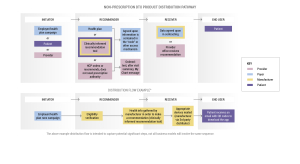In the rapidly evolving landscape of healthcare, digital therapeutics (DTx) have emerged as a promising solution for improving patient outcomes and augmenting traditional medical interventions. In the recent webinar, Non-Prescription DTx Integration Workflows, the Digital Therapeutics Alliance (DTA) welcomed member companies, Sanofi and Woebot Health, along with an employer representative from WalkMe, to discuss how stakeholders come together to offer non-prescription DTx to employees.
Understanding Digital Therapeutics
Digital therapeutics are health softwares intended to treat or alleviate a disease, disorder, condition, or injury by generating and delivering a medical intervention that has a demonstrable positive therapeutic impact on a patient’s health. Digital therapeutics have the potential to benefit employees by providing accessible treatment for a wide variety of conditions.
Bringing Digital Therapeutics to Life: Workflows and Distribution Models
 Bringing digital therapeutics into the healthcare ecosystem involves navigating complex workflows and distribution models. From the manufacturer’s perspective, it requires a comprehensive understanding of the needs of both patients and employers, as well as collaboration with various stakeholders to ensure successful adoption.
Bringing digital therapeutics into the healthcare ecosystem involves navigating complex workflows and distribution models. From the manufacturer’s perspective, it requires a comprehensive understanding of the needs of both patients and employers, as well as collaboration with various stakeholders to ensure successful adoption.
Distribution Models for Non-Prescription Products
 The distribution of non-prescription digital therapeutics involves multiple stakeholders, including initiators, recommenders, receivers, and end-users. Initiators (health plans, employers, patients, or providers) play a pivotal role in recommending and facilitating access to these products.
The distribution of non-prescription digital therapeutics involves multiple stakeholders, including initiators, recommenders, receivers, and end-users. Initiators (health plans, employers, patients, or providers) play a pivotal role in recommending and facilitating access to these products.
Recommenders (health plans) employ various methods, such as text message campaigns or including digital therapeutics recommendations in after-visit summaries, to provide access to patients. Receivers (the provider) must ensure data exchange agreements are in place to safeguard patient privacy and security.
Ultimately, the end-user (the patient) stands to benefit from the accessibility and quality offered by non-prescription digital therapeutics.
Employer Perspective: A Case Study
Let’s delve into a real-world scenario to understand how employers play a crucial role in facilitating the adoption of DTx and other digital health technologies (DHTs). Consider Jeremy, an employer representative, tasked with identifying and implementing digital solutions to address the health needs of his organization’s employees.
Jeremy’s journey begins with identifying the specific health needs of employees through direct outreach and engagement. Once the needs are identified, Jeremy collaborates with a broker to vet solutions that align with these needs. Demos and presentations from manufacturers play a pivotal role in the decision-making process, providing valuable insights into the functionality and efficacy of the products.
Multiple teams within the organization, including finance, information security, and legal, are involved in evaluating and implementing solutions to close gaps in healthcare delivery and improving outcomes for their employees. Understanding the needs and priorities of employers, such as data exchange, privacy, and security, is crucial during the contracting process.
Key Performance Indicators (KPIs) should be established early on to measure engagement and outcomes. This enables both parties to track progress and make data-driven decisions to optimize the effectiveness of digital therapeutics solutions.
Successful implementation of DTx requires a collaborative effort between manufacturers and employers with roles and responsibilities clearly mapped out. Manufacturers must provide clear and compelling promotional materials, including demos, to showcase the value of their products.
Conclusion
Digital therapeutics represent a paradigm shift in healthcare delivery, offering innovative solutions to address the evolving needs of patients and employers alike. By understanding the workflows and distribution models involved, manufacturers and employers can collaborate effectively to drive the adoption and utilization of digital therapeutics, ultimately improving patient outcomes and transforming the future of healthcare.
Learn more about DTA’s 2024 DTx Integration and Workflow Report.